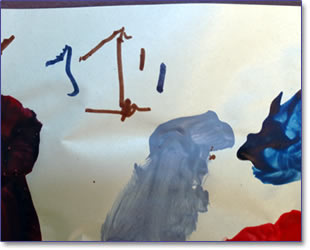 |
|
As you immerse your students in opportunities for writing and give them reasons for writing, by writing in front of them, your students will pay more attention to the details that distinguish letter marks from picture marks. As they gain experience their “scribbles" for writing will look more linear, circular, and “letter-like.” Later in the year, you should easily be able to distinguish their “writing” from their “drawing.”
As their writing experience expands, children develop an increased knowledge about the forms of letters. They begin to recognize that these 26 alphabet letters they see everywhere are used to write messages. You may notice children using the letters in their names in various patterns and combinations to record their messages independently. You may also notice children copying or writing words they see around them. Such activities support their explorations of print and letter formation. As they learn how to write more letters, new letters will be added to their writing capabilities. Children will also begin to experiment with different forms and functions of writing. You will see them writing grocery lists and taking phone messages when they play at housekeeping. You might see them writing page-long stories at the writing center or using letters to write captions and labels for their paintings and block creations.
As children get ready for kindergarten they should be able to write their own names and many of the letters of the alphabet independently. You may see some children using appropriate letters for the beginning and/or ending sounds for prominent words in their messages. When children learn how to isolate sounds to identify the correct letter-spelling of words, they are demonstrating their growing phonemic awareness and increasing knowledge of letter-sound correspondences. You may also observe some children trying to figure out where to leave spaces between words. Sometimes they will get it right when writing independently, and sometimes there will be several “words” squashed together with no spaces.
Keep in mind that some children will still be developing correct letter formation. You may see capital E’s with more than three horizontal lines, capital R’s with a misplaced diagonal, or some backwards letters, but you will be able to identify the letters being represented. In addition, some children are still making sense of how to put their messages on paper and how their writing needs to be organized. So don’t be surprised when you see children occasionally writing backwards, or starting the first line of their message by writing from left to right, and continuing on the next line by moving from right to left. Young children are still learning about directionality and placement in writing. At this age, writing letters backwards is NOT a sign of dyslexia. |